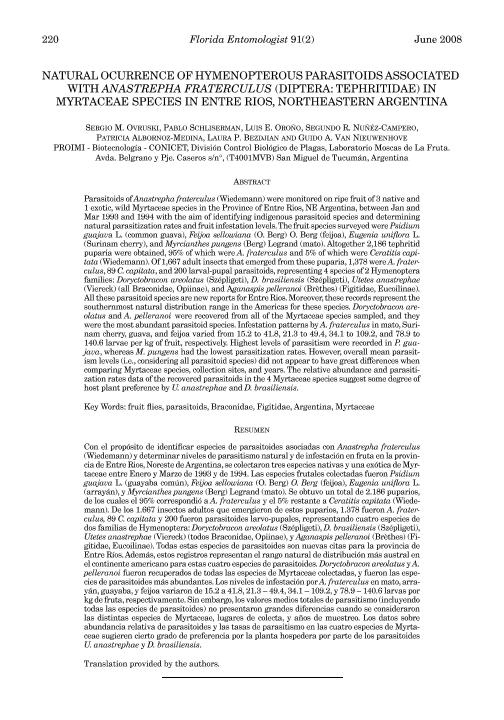Mostrar el registro sencillo del ítem
dc.contributor.author
Ovruski Alderete, Sergio Marcelo

dc.contributor.author
Schliserman, Pablo

dc.contributor.author
Oroño, Luis Eduardo

dc.contributor.author
Núñez Campero, Segundo Ricardo

dc.contributor.author
Albornoz Medina, Patricia

dc.contributor.author
Bezdjian, Laura Patricia

dc.contributor.author
Van Nieuwenhove, Guido Alejandro

dc.date.available
2018-04-18T14:12:04Z
dc.date.issued
2008-06
dc.identifier.citation
Ovruski Alderete, Sergio Marcelo; Schliserman, Pablo; Oroño, Luis Eduardo; Núñez Campero, Segundo Ricardo; Albornoz Medina, Patricia; et al.; Natural occurrence of parasitoids (Hymenoptera) associated with Anastrepha fraterculus (Diptera: Tephritidae) in myrtaceae species in the northeastern province of Entre Rios, Argentina; Florida Entomological Society; Florida Entomologist; 91; 2; 6-2008; 220-227
dc.identifier.issn
0015-4040
dc.identifier.uri
http://hdl.handle.net/11336/42434
dc.description.abstract
Parasitoids of Anastrepha fraterculus (Wiedemann) were monitored on ripe fruit of 3 native and 1 exotic, wild Myrtaceae species in the Province of Entre Rios, NE Argentina, between Jan and Mar 1993 and 1994 with the aim of identifying indigenous parasitoid species and determining natural parasitization rates and fruit infestation levels. The fruit species surveyed were Psidium guajava L. (common guava), Feijoa sellowiana (O. Berg) O. Berg (feijoa), Eugenia uniflora L. (Surinam cherry), and Myrcianthes pungens (Berg) Legrand (mato). Altogether 2,186 tephritid puparia were obtained, 95% of which were A. fraterculus and 5% of which were Ceratitis capitata (Wiedemann). Of 1,667 adult insects that emerged from these puparia, 1,378 were A. fraterculus, 89 C. capitata, and 200 larval-pupal parasitoids, representing 4 species of 2 Hymenoptera families: Doryctobracon areolatus (Szépligeti), D. brasiliensis (Szépligeti), Utetes anastrephae (Viereck) (all Braconidae, Opiinae), and Aganaspis pelleranoi (Brèthes) (Figitidae, Eucoilinae). All these parasitoid species are new reports for Entre Rios. Moreover, these records represent the southernmost natural distribution range in the Americas for these species. Doryctobracon areolatus and A. pelleranoi were recovered from all of the Myrtaceae species sampled, and they were the most abundant parasitoid species. Infestation patterns by A. fraterculus in mato, Surinam cherry, guava, and feijoa varied from 15.2 to 41.8, 21.3 to 49.4, 34.1 to 109.2, and 78.9 to 140.6 larvae per kg of fruit, respectively. Highest levels of parasitism were recorded in P. guajava, whereas M. pungens had the lowest parasitization rates. However, overall mean parasitism levels (i.e., considering all parasitoid species) did not appear to have great differences when comparing Myrtaceae species, collection sites, and years. The relative abundance and parasitization rates data of the recovered parasitoids in the 4 Myrtaceae species suggest some degree of host plant preference by U. anastrephae and D. brasiliensis.
dc.format
application/pdf
dc.language.iso
eng
dc.publisher
Florida Entomological Society

dc.rights
info:eu-repo/semantics/openAccess
dc.rights.uri
https://creativecommons.org/licenses/by-nc-sa/2.5/ar/
dc.subject
Fruit Flies
dc.subject
Parasitoids
dc.subject
Braconidae
dc.subject
Figitidae
dc.subject
Argentina
dc.subject
Myrtaceae
dc.subject.classification
Otras Ciencias Biológicas

dc.subject.classification
Ciencias Biológicas

dc.subject.classification
CIENCIAS NATURALES Y EXACTAS

dc.title
Natural occurrence of parasitoids (Hymenoptera) associated with Anastrepha fraterculus (Diptera: Tephritidae) in myrtaceae species in the northeastern province of Entre Rios, Argentina
dc.type
info:eu-repo/semantics/article
dc.type
info:ar-repo/semantics/artículo
dc.type
info:eu-repo/semantics/publishedVersion
dc.date.updated
2018-04-16T13:36:35Z
dc.journal.volume
91
dc.journal.number
2
dc.journal.pagination
220-227
dc.journal.pais
Estados Unidos

dc.journal.ciudad
Nueva York
dc.description.fil
Fil: Ovruski Alderete, Sergio Marcelo. Consejo Nacional de Investigaciones Científicas y Técnicas. Centro Científico Tecnológico Conicet - Tucumán. Planta Piloto de Procesos Industriales Microbiológicos; Argentina
dc.description.fil
Fil: Schliserman, Pablo. Consejo Nacional de Investigaciones Científicas y Técnicas. Centro Científico Tecnológico Conicet - Tucumán. Planta Piloto de Procesos Industriales Microbiológicos; Argentina
dc.description.fil
Fil: Oroño, Luis Eduardo. Consejo Nacional de Investigaciones Científicas y Técnicas. Centro Científico Tecnológico Conicet - Tucumán. Planta Piloto de Procesos Industriales Microbiológicos; Argentina
dc.description.fil
Fil: Núñez Campero, Segundo Ricardo. Consejo Nacional de Investigaciones Científicas y Técnicas. Centro Científico Tecnológico Conicet - Tucumán. Planta Piloto de Procesos Industriales Microbiológicos; Argentina
dc.description.fil
Fil: Albornoz Medina, Patricia. Consejo Nacional de Investigaciones Científicas y Técnicas. Centro Científico Tecnológico Conicet - Tucumán. Planta Piloto de Procesos Industriales Microbiológicos; Argentina
dc.description.fil
Fil: Bezdjian, Laura Patricia. Consejo Nacional de Investigaciones Científicas y Técnicas. Centro Científico Tecnológico Conicet - Tucumán. Planta Piloto de Procesos Industriales Microbiológicos; Argentina
dc.description.fil
Fil: Van Nieuwenhove, Guido Alejandro. Consejo Nacional de Investigaciones Científicas y Técnicas. Centro Científico Tecnológico Conicet - Tucumán. Planta Piloto de Procesos Industriales Microbiológicos; Argentina
dc.journal.title
Florida Entomologist

dc.relation.alternativeid
info:eu-repo/semantics/altIdentifier/url/http://journals.fcla.edu/flaent/article/view/75792
dc.relation.alternativeid
info:eu-repo/semantics/altIdentifier/doi/https://doi.org/10.1653/0015-4040(2008)91[220:NOOHPA]2.0.CO;2
dc.relation.alternativeid
info:eu-repo/semantics/altIdentifier/url/http://www.bioone.org/doi/abs/10.1653/0015-4040%282008%2991%5B220%3ANOOHPA%5D2.0.CO%3B2
Archivos asociados
